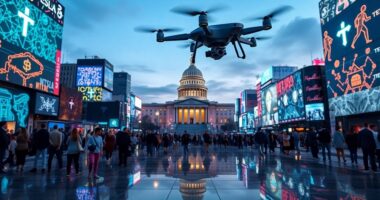Machine learning helps your company predict shortages before they happen, giving you a vital competitive edge. By analyzing large data sets like job ads and supply patterns, it identifies early warning signs of resource gaps. You can proactively manage inventories, adjust workforce strategies, and strengthen supply chain resilience. Implementing models such as random forests or neural networks makes these predictions more accurate. If you continue exploring, you’ll discover how to leverage these tools to stay ahead in your industry.
Key Takeaways
- Machine learning analyzes large data sets to predict supply gaps before shortages occur.
- It utilizes real-time job ad data to monitor labor demand trends proactively.
- ML models like XGBoost and neural networks forecast shortages with high accuracy across industries.
- Algorithms such as random forests and support vector machines identify risk patterns early.
- Implementing ML enhances supply chain resilience and enables proactive resource management.

In today’s fast-changing markets, companies that leverage machine learning can stay ahead of shortages before they happen. These advanced models analyze vast amounts of data to predict supply gaps accurately, giving you a critical edge in managing resources. For instance, algorithms like XGBoost can forecast labor shortages with a macro-F1 score of up to 86%, meaning you can trust their predictions to identify potential workforce gaps early. By examining combined labor demand and supply data, these models reveal patterns that might otherwise go unnoticed, enabling you to act proactively rather than reactively. Research demonstrates that integrating real-time job advertisement data enhances the predictive capabilities of these models, allowing for more timely and precise forecasts.
Job advertisement data plays a key role in these predictions. It acts as a proxy for labor demand trends, offering real-time insights into hiring activity. When an increase or decrease in job postings is detected, your company can interpret this as an early warning sign of future shortages in specific roles or industries. This allows you to adjust recruitment strategies or plan upskilling initiatives well in advance, reducing the risk of critical talent gaps.
ML models aren’t limited to labor markets; they effectively forecast shortages across diverse sectors like pharmaceuticals. In healthcare, for example, these models can predict drug shortages with around 80% accuracy, with most predictions showing less than a 0.10 mean absolute error, or MAE. Such precision helps healthcare providers anticipate supply disruptions, ensuring that essential medications remain available when needed most. By integrating ensemble methods like random forests and gradient boosting, predictions become more accurate and robust, as these techniques combine multiple models to counteract overfitting and improve reliability.
Healthcare supply predictions reach 80% accuracy with less than 0.10 MAE using ensemble methods like random forests and gradient boosting.
Different algorithms serve specific roles in shortage forecasting. Decision trees help model decision-making processes based on categorical or numerical data, while random forests improve overall prediction accuracy by aggregating multiple trees. Support vector machines classify patterns in shortage history, and K-nearest neighbors compare current situations with similar past instances to identify risks. Neural networks excel at capturing complex, nonlinear relationships, enhancing both demand and shortage forecasts.
Implementing machine learning transforms your operations. It enables proactive workforce planning, smarter inventory management, and reduced costs associated with emergency procurement. By accurately predicting shortages, you can minimize stockouts, avoid excess inventory, and adapt quickly to market changes or technological shifts. This strategic foresight supports better talent acquisition, skill gap analysis, and supply chain resilience. Ultimately, machine learning helps you navigate the complexities of today’s dynamic markets, ensuring you’re prepared for shortages before they disrupt your business.
Frequently Asked Questions
How Does Machine Learning Improve Supply Chain Forecasting Accuracy?
Machine learning improves your supply chain forecasting accuracy by analyzing vast and varied data sources, including external factors like weather and social media. It adapts in real-time to market changes, identifies patterns even when historical data is limited, and fine-tunes predictions through hyperparameter adjustments. This leads to lower errors, better inventory management, fewer stockouts, and reduced operational costs, ultimately making your supply chain more responsive and efficient.
What Industries Benefit Most From Predictive Shortage Management?
You’ll find industries like manufacturing, transportation, energy, and telecommunications benefit most from predictive shortage management. When you use machine learning, you can anticipate supply disruptions, prevent equipment failures, and optimize maintenance schedules. This proactive approach reduces downtime, cuts costs, and guarantees continuous operations. By staying ahead of shortages, you help your company maintain efficiency and reliability, even amid unpredictable demand or supply chain hiccups, giving you a competitive edge.
Are There Ethical Concerns With Using Machine Learning for Inventory Control?
Yes, there are ethical concerns with using machine learning for inventory control. You might unintentionally perpetuate biases if your data isn’t representative, leading to unfair supplier treatment or resource distribution. Transparency can also be an issue, making it hard to explain decisions or assign responsibility. Additionally, data privacy and security become critical, especially when handling sensitive information. Balancing automation benefits with fairness, accountability, and privacy is essential to ethically deploy AI in inventory management.
How Much Does Implementing Machine Learning Cost for Small Businesses?
Implementing machine learning for your small business is like planting a seed—initial costs can range from $10,000 to $150,000, depending on your needs. Basic solutions like chatbots cost less, while customized models need a bigger investment. Keep in mind, ongoing expenses for cloud services and data management add to the total. Starting small with ready-made AI can give you a taste of benefits without breaking the bank.
What Are Common Challenges in Integrating Machine Learning Into Existing Systems?
You’ll face challenges like needing specialized skills and data quality issues when integrating ML into your existing systems. Hiring experts or upskilling staff takes time and money, which can delay deployment. You’ll also need to break down data silos and adapt legacy systems for smooth integration. Plus, managing organizational change and overcoming employee resistance are vital to guarantee successful adoption of ML technology.
Conclusion
By leveraging machine learning, you can stay ahead of shortages and keep your operations smooth. These tools give you the insights needed to react quickly and make smarter decisions. Remember, an ounce of prevention is worth a pound of cure—staying proactive with AI can save you time and money. Embrace these technologies now, and you’ll be better prepared for whatever challenges come your way. The early bird catches the worm—don’t wait until it’s too late.









